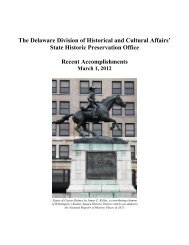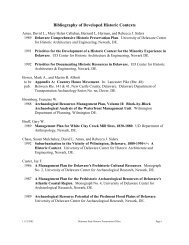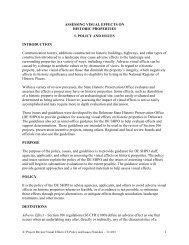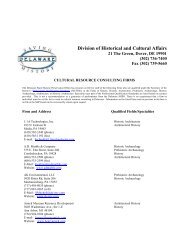Report of the Archaeological Investigations of the New Castle Court ...
Report of the Archaeological Investigations of the New Castle Court ...
Report of the Archaeological Investigations of the New Castle Court ...
You also want an ePaper? Increase the reach of your titles
YUMPU automatically turns print PDFs into web optimized ePapers that Google loves.
4.4.2 CORAL<br />
NEW CASTLE COURT HOUSE PLAZA<br />
NEW CASTLE, DELAWARE<br />
4.0 ARTIFACT ANALYSIS<br />
Unexpectedly, a large amount <strong>of</strong> coral was recovered from Feature 20 (Plate 22), with lesser<br />
quantities documented from Feature 23 and SUs B and C. From all contexts, approximately 170<br />
pounds <strong>of</strong> coral were recovered. Fragments ranged from half dollar to basketball-sized pieces<br />
weighing nearly 11 pounds. Three varieties <strong>of</strong> coral were identified: “brain coral” (diploria<br />
strigosa), a bulky and frond-like coral (acropora palmata), and a species called monatstrea<br />
annularsi.<br />
JMA consulted with Dr. John M. Pandolfi, Research Paleobiologist and Curator <strong>of</strong> Fossil Corals<br />
at <strong>the</strong> Smithsonian National Museum <strong>of</strong> Natural History regarding possible environmental and<br />
locational information for <strong>the</strong> <strong>Court</strong> House corals. Dr. Pandolfi identified <strong>the</strong> location <strong>of</strong> origin as<br />
<strong>the</strong> Caribbean. Dr. Pandolfi explained that it is difficult to determine what environment (barrier or<br />
fringing reef) that <strong>the</strong> coral may have been harvested from. It is equally difficult to determine<br />
what islands <strong>the</strong> corals may have come from. Given <strong>New</strong> <strong>Castle</strong>’s strong ties to Dutch-occupied<br />
islands, Dr. Pandolfi suggested that <strong>the</strong> Dutch Antilles islands <strong>of</strong> Curaco, Aruba, and Bonaire<br />
may be possible sources for <strong>the</strong> <strong>Court</strong> House corals (John Pandolfi, personal communication,<br />
April 12 and 14, 2004).<br />
Coral is <strong>of</strong>ten reported from archeological excavations at waterfront sites and docks from places<br />
such as <strong>New</strong> York City, and Providence, <strong>New</strong> Hampshire (Cantwell and Wall 2001:227; Pendery<br />
1980). In <strong>the</strong>se places <strong>the</strong> coral has been interpreted as a remnant <strong>of</strong> ships’ ballast, brought from<br />
<strong>the</strong> Caribbean; in <strong>New</strong> York excavations ballast has also included coralline sand (Cantwell and<br />
Wall 2001:234; Geismar 1987:52). However, <strong>the</strong> presence <strong>of</strong> <strong>the</strong> coral in <strong>the</strong> <strong>New</strong> <strong>Castle</strong> <strong>Court</strong><br />
House deposits is unusual on terrestrial colonial archeological sites in <strong>the</strong> Middle Atlantic,<br />
especially considering <strong>the</strong> quantity that was found.<br />
Previously in <strong>New</strong> <strong>Castle</strong>, four fragments <strong>of</strong> coral (one brain coral and three elkhorn corals) were<br />
recovered from Level I <strong>of</strong> <strong>the</strong> archeological excavations at Immanuel Church (John Milner<br />
Associates, Inc. 1984:180; hereafter JMA). Level I contained artifacts dating from <strong>the</strong> early<br />
eighteenth century until 1860 (JMA 1984:165). One fragment <strong>of</strong> brain coral was also recovered<br />
from a circa 1750 feature in <strong>the</strong> Area F excavations at Independence Hall in Philadelphia (Juliette<br />
Gerhardt, personal communication, August 2004). Coral has also been reported from <strong>the</strong><br />
excavations at <strong>the</strong> John Read House in <strong>New</strong> <strong>Castle</strong> (Lu Ann De Cunzo, personal communication<br />
February 2006).<br />
As it was explained in <strong>the</strong> report <strong>of</strong> <strong>the</strong> Immanuel Church investigations, “<strong>the</strong> presence <strong>of</strong> <strong>the</strong><br />
coral in local beach sand cannot be attributed to natural processes <strong>of</strong> currents, tides, and wave<br />
action but probably represents discarded ship’s trash or ballast dumped at or near <strong>New</strong> <strong>Castle</strong><br />
before proceeding up <strong>the</strong> river” (JMA 1984:180). The additional finds <strong>of</strong> coral at <strong>the</strong> nearby<br />
<strong>Court</strong> House tends to confirm this earlier conclusion. It is likely that <strong>the</strong> primary purpose or<br />
function <strong>of</strong> <strong>the</strong> corals could have been as ships’ ballast, as construction material (a source <strong>of</strong> lime<br />
for mortar), or as a road “cobbling” material. Ultimately, <strong>the</strong> secondary role <strong>of</strong> <strong>the</strong> coral was as<br />
backfill for <strong>the</strong> features on <strong>the</strong> grounds <strong>of</strong> <strong>the</strong> <strong>Court</strong> House.<br />
An example <strong>of</strong> early eighteenth-century mining <strong>of</strong> coral and limestone for use as ships’ ballast<br />
has been reported as occurring on Water Island located one-half mile south <strong>of</strong> St. Thomas in <strong>the</strong><br />
US Virgin Islands (Anderson 1998). A fragment <strong>of</strong> coral has also been recovered from <strong>the</strong><br />
excavation <strong>of</strong> <strong>the</strong> Puddle Dock at Strawberry Bank in Providence, <strong>New</strong> Hampshire. Providence<br />
carried on a significant trade with <strong>the</strong> West Indies from circa 1690 until <strong>the</strong> trade was disrupted<br />
69









